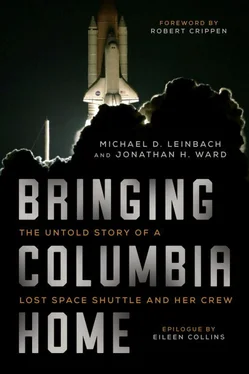Firing Room 4 of the Launch Control Center was already a hive of activity when I arrived the night before the launch. Roughly 180 engineers and managers controlled the countdown activities from that room. They were supported by about as many people in the backup Firing Room—the systems experts who knew the vehicle and ground support systems better than anyone. They were on hand to help resolve the usual technical glitches that cropped up during the countdown. VIPs and the prelaunch Mission Management Team observed the proceedings from the two glass-walled “bubbles” flanking the top row of consoles and my station.
A multiagency command center was created for this mission and operated from the second floor of the Launch Control Center. FBI, CIA, and state and local security forces staffed the command center and monitored the operations. Mark Borsi, director of KSC security, reported directly to me on the status of security measures and issues. I also had direct access to coast guard and air force brass via my console.
After two years of rescheduling and delays, launch day for STS-107 finally dawned on January 16, 2003.
In the early morning hours, ground systems pumped 146,000 gallons of liquid oxygen and 396,000 gallons of liquid hydrogen into the shuttle’s external tank. At T minus three hours in the countdown, we deployed the Ice Team to the launchpad for a two-hour inspection of Columbia and the pad systems. The Ice Team used binoculars, telephoto lenses, and infrared devices to check for any unusual ice buildup or other debris on the surface of the vehicle, because the super-cooled liquid propellants in the tank might cause ice to form from the always-humid Florida Coast air. A chunk of ice falling off the tank or a booster and striking the orbiter during the ride into orbit could doom the shuttle. The team saw nothing unusual, and they reported their findings back to us in the Firing Room. The countdown proceeded relatively smoothly.
In the Operations and Checkout Building eight miles from the launchpad, astronauts Jerry Ross, Kent “Rommel” Rominger (chief of the astronaut corps), and Bob Cabana (director of flight crew operations) were on hand as Columbia ’s crew suited up before the flight. Robert Hanley, who reported to Ross, filmed the proceedings with Dave Brown’s video camera. Brown requested that Hanley videotape the suit-up and walkout as part of the commemorative video that Brown was compiling about the crew’s training. As the crew and their entourage walked out of the building toward the waiting Astrovan, Rick Husband and Willie McCool reached overhead and touched their hands to the STS-107 mission decal on the head of the door frame. It was yet another of the good-luck traditions for space travelers.
The Astrovan drove north to the corner of Kennedy Parkway and Saturn Causeway, near the Vehicle Assembly Building. There, the van stopped to let out Rominger, who went to the Shuttle Landing Facility. He would then fly the Shuttle Training Aircraft around the KSC area to monitor weather conditions throughout the remainder of the launch countdown. NASA needed firsthand accounts of visibility and winds aloft, in case Columbia needed to make an emergency return to the runway. Cabana, Ross, and Hanley said their good-byes to the crew and left the van at the checkpoint by the Launch Control Center. Ross and Hanley joined the crew families in the Launch Control Center. Cabana went to the “bubble” adjacent to the Firing Room to join the Mission Management Team. The flight surgeon came in to man the Firing Room’s biomedical console.
The STS-107 crew rode the remaining three and a half miles to the pad. After pausing for a quick look up at Columbia , they took the short elevator ride to the 195-foot level on the Fixed Service Structure, and walked across the crew access arm to the White Room. Over the next fifty minutes, the pad closeout crew strapped the astronauts into their seats, and then sealed the hatch. The astronauts went through their checklists for the final stages of the launch countdown.
—
The children of Columbia ’s crew busied themselves drawing with markers on a whiteboard near my office on the fourth floor of the LCC as the final hours of the countdown ticked by. It was another of the KSC launch traditions—a way to keep the kids occupied during what would otherwise be a tedious time for them and to afford their parents some time to be alone with their thoughts. In the days following the launch, our staff would frame the children’s whiteboard art and mount it in the hallway to join the scores of “kid pics” from previous missions.
When the countdown came out of the final scheduled hold at T minus nine minutes, escorts took the children and the rest of the immediate members of the crew’s families out onto the LCC roof and up a stairway to a private viewing area. There they could watch the launch, shielded from the eyes of the press and public—a precaution we implemented after the Challenger disaster.
In the Firing Room two floors below, my launch team prepared to come out of the hold. It was a final chance for managers and engineers to catch their breath and work any last-minute issues. Things would move very rapidly once the count started up again, almost entirely under control of the ground launch sequencing computers.
We were not nervous, but the atmosphere was charged and intense. The room was dead quiet. Launching a space shuttle is never routine.
That intensity went to a whole new level for me when I received a call on the secure line from the air force. Their tracking radar showed an unidentified object due south of the launch complex, heading due north.
Estimated time of arrival at the launchpad area: T-0.
Holy shit. This is it. We’re under attack.
I received several reports of the object’s position, and the command center team plotted its course. Then it disappeared from the radar screen. It reappeared and disappeared several more times over the next couple of minutes.
What the hell is going on?
I called the general who was my liaison at the Department of Defense. He had a direct line to the president in case authorization was needed to shoot down a civilian airplane. The general relayed to me what the pilot of the air force jet circling overhead was saying. Secondhand information always has the possibility of being misinterpreted. I said, “Sir, I trust you completely, but I need to speak to the pilot directly.” The general objected at first, as this was a breach of protocol between the military and a civilian agency. I insisted, and a few seconds later, they patched me through to the pilot.
My hands were shaking. I held onto my console to steady myself. I asked the pilot, “Sir, if there was anything out there, would you see it?”
The pilot responded, “Yes, sir, I would.”
“And do you see anything?”
“No, sir, I don’t.”
I was listening carefully to the pilot’s choice of words and the tone of his voice. If he had said, “I don’t think I see anything,” or if there had been any hint of uncertainty in his voice, I probably would have told the crew to punch out, ordering them to make an emergency egress. However, the pilot sounded completely confident.
All the months of planning, the security exercises, the resources deployed, the years of the crew waiting for the mission to fly, the relentless training, the scheduling pressure to fly this mission—it all came down to this decision.
Was there an emergency or not?
At the end of the final countdown hold, my tradition was always to give the crew an upbeat send-off message on behalf of the launch team. I got on the comm loop with Rick Husband and said, “If there ever was a time to use the phrase, ‘Good things come to people who wait,’ this is the one time. From the many, many people who put this mission together: Good luck and Godspeed.”
Читать дальше











